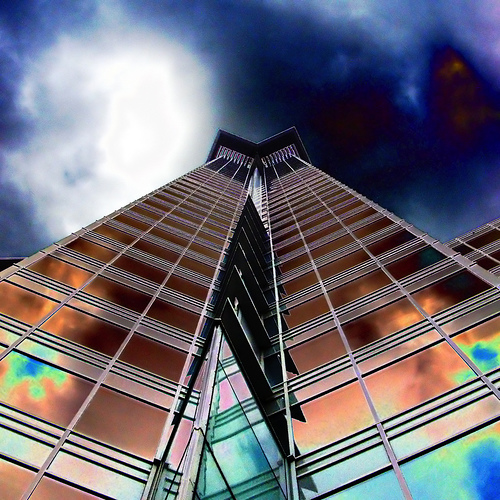January 8, 2012


Florida-based SAF-GLAS, which creates disaster-resistant and security-related glass products, recently introduced EnergyGlass at a solar seminar at GlassBuild America. This transparent glass incorporates inorganic nanoparticles into clear laminated glass. With its use of a proprietary polycarbonate interlayer and patented film, this turns a window into a 24-hour a day solar “farm.” (Photo by Ecstaticist, Flickr)
[nggallery id=89 template=carousel images=4] [imagebrowser id=89] By Debra Atlas January 8, 2012
With the growing emphasis on alternative energy sources and solar power, rooftop solar arrays are springing up around the country. As useful and environmentally-friendly as photovoltaic panels are, they don’t exactly blend in aesthetically. What’s more, they can sometimes be difficult to integrate with other rooftop equipment, and can sustain damage from exposure to the elements.
Florida-based SAF-GLAS, which creates disaster-resistant and security-related glass products, recently introduced EnergyGlass at a solar seminar at GlassBuild America. This transparent glass incorporates inorganic nanoparticles into clear laminated glass. With its use of a proprietary polycarbonate interlayer and patented film, this turns a window into a 24-hour a day solar “farm.”
The first of its kind, EnergyGlass goes beyond the capabilities of traditional solar power panels, which depend on both placement and angling in direct sunlight. It’s able to collect light from natural, ambient and artificial light sources such as hotel or office lighting. Once collected, the light is transformed into electricity, then used or sent for storage to a backup battery system for power outages or other emergency situations.
Unlike other solar windows, EnergyGlass windows have no lines or mesh incorporated into them. You get a clear view of the outdoors, as with any standard window.
EnergyGlass can be fashioned to any size, shape or style and can be installed in a vertical or horizontal position. Each window is made of two clear glass panels with a solar laminate sandwiched between them, creating a single laminated solar pane. It can be tinted, insulated and can even incorporate Low E glass and other related products to create additional energy savings.
This glass has numerous other applications. By including additional laminating procedures, it can be used in combination with security glass to meet hurricane, typhoon, tornado, forced entry, bullet resistant, bomb blast, and fire protection levels.
These solar power glass windows do share some of the benefits of solar panels. The electricity they generate allows building owners to sell electricity back to the main electrical grid and generate income.
“The nanoparticles in the laminate magnify and redirect the light to the edges of the glass, and then into our proprietary window edge frames,” says SAF-GLAS co-founder Art Marino.
However, EnergyGlass won’t produce as much electricity as traditional photovoltaic (PV) panels. “The glass only features thin strips of monocrystalline cells, located around the edge of the laminated glass panel,” says SAF-GLAS owner Patrick Smith.
“They took a product from the solar industry and married it with a relatively standard glazing industry product” says Steve Coonen, BIPV consultant and principal, PV Glassworks, Grass Valley, California.
EnergyGlass can be used for both new and retrofit applications. It qualifies for numerous local, state, and Federal government rebates, incentives and subsidies that can cover up to 70 percent of total facade project costs.
Currently the company is offering quotes on EnergyGlass installations and anticipates it will be available for sale on the market this first quarter 2012.
Check out more articles by Debra Atlas
For related article, see: Triple Benefits of Solar-Powered EV Chargers
© 2012 SCGH, LLC.
]]>